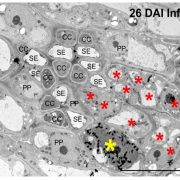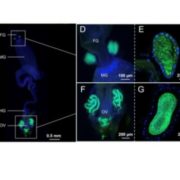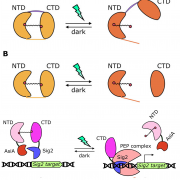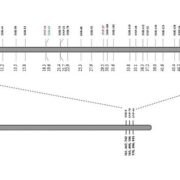Bioengineered “pikobodies” confer plant disease resistance
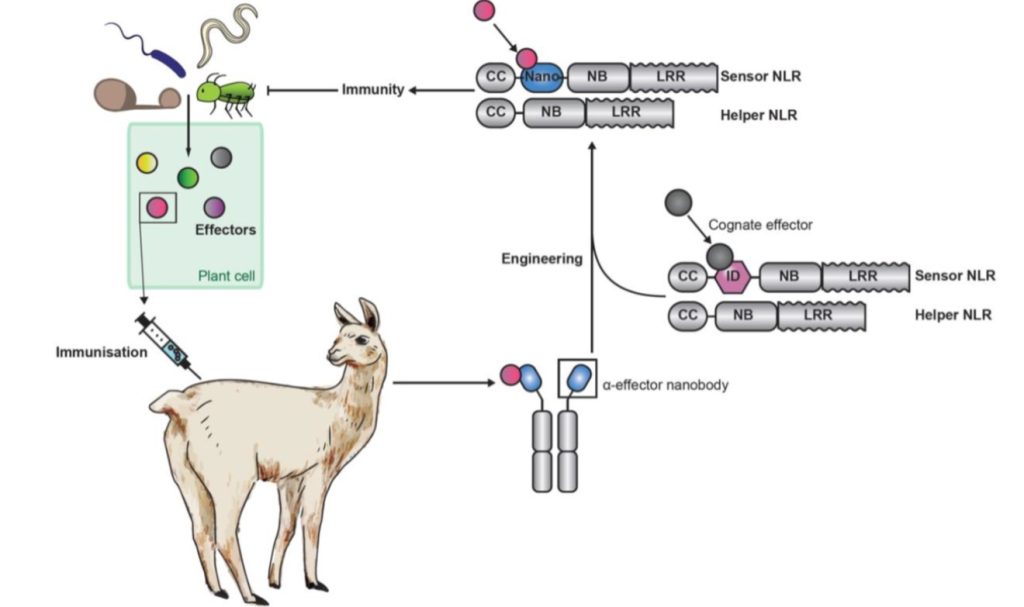 The vertebrate adaptive immune system is truly an evolutionary marvel. With its ability to mix-and-match segments of immunoglobulin genes, a nearly unlimited diversity of antigens can be recognized. Plants lack this ability, greatly limiting the number of antigens (and pathogens) any individual can recognize. Kourelis et al. did a “what if” experiment; what if plants could acquire some features of this adaptive immune system? To address this, they created fusions of segments of Pik-1, a NLR plant immune protein, to variable domains of naturally occurring single-chain antibodies that are produced in camelid animals and that are known as nanobodies. The results of this fusion combine the versatility of the animal antigen recognition domain with the endogenous immune function of the plant protein. As proof of concept, they spliced nanobody domains recognizing GFP or RFP into Pik-1, introduced the new protein along with its activity partner Pik-2 (they pair is collectively referred to as a pikobody) in Nicotiana benthamiana leaves and showed that the pikobodies promote an immune response in the presence of the corresponding fluorescent protein; in effect, they turned the fluorescent proteins into synthetic avirulence proteins (AVRs). The authors further showed that the pikobodies confer resistance to viruses carrying the fluorescent-protein antigen. As they observe, this technology could lead to “made to order” resistance genes; a pathogen effector would be used to raise nanobodies in an animal, with the corresponding nanobody gene lending its recognition domain to the pikobodies, which would be expressed in the plant. And bingo! Pathogen recognized and defenses deployed. (Summary by Mary Williams @PlantTeaching) Science 10.1126/science.abn4116
The vertebrate adaptive immune system is truly an evolutionary marvel. With its ability to mix-and-match segments of immunoglobulin genes, a nearly unlimited diversity of antigens can be recognized. Plants lack this ability, greatly limiting the number of antigens (and pathogens) any individual can recognize. Kourelis et al. did a “what if” experiment; what if plants could acquire some features of this adaptive immune system? To address this, they created fusions of segments of Pik-1, a NLR plant immune protein, to variable domains of naturally occurring single-chain antibodies that are produced in camelid animals and that are known as nanobodies. The results of this fusion combine the versatility of the animal antigen recognition domain with the endogenous immune function of the plant protein. As proof of concept, they spliced nanobody domains recognizing GFP or RFP into Pik-1, introduced the new protein along with its activity partner Pik-2 (they pair is collectively referred to as a pikobody) in Nicotiana benthamiana leaves and showed that the pikobodies promote an immune response in the presence of the corresponding fluorescent protein; in effect, they turned the fluorescent proteins into synthetic avirulence proteins (AVRs). The authors further showed that the pikobodies confer resistance to viruses carrying the fluorescent-protein antigen. As they observe, this technology could lead to “made to order” resistance genes; a pathogen effector would be used to raise nanobodies in an animal, with the corresponding nanobody gene lending its recognition domain to the pikobodies, which would be expressed in the plant. And bingo! Pathogen recognized and defenses deployed. (Summary by Mary Williams @PlantTeaching) Science 10.1126/science.abn4116



